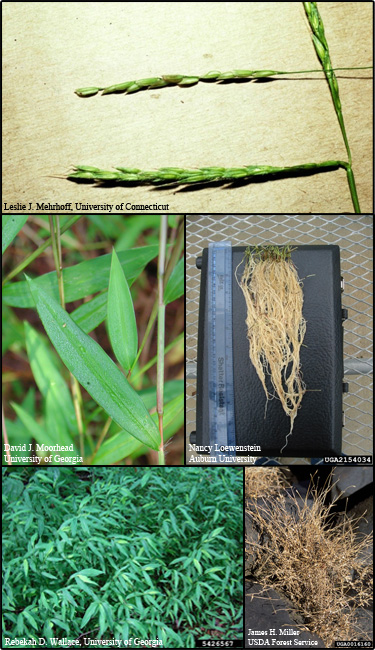Japanese stiltgrass (Microstegium vimineum)
 Common Names: Nepalese browntop, Chinese packing grass, Basketgrass, Microstegium
Common Names: Nepalese browntop, Chinese packing grass, Basketgrass, MicrostegiumDescription: Introduced into the United States in Tennessee around 1919 and likely escaped as a result of its use as a packing material for porcelain.
Habit: Annual; grass, reaching 1 m (3.25 ft) in length. Lies on ground and roots at nodes along stems; upright branches look like individual plants.
Leaves: Alternate, pale green; asymmetrical; lanceolate; slightly pubescent; 5-8 cm (1.25-2 in) long, with a silvery line along the center of the blade.
Stems: Thin, weak roots form along the stem at nodes.
Flowers: Terminal racemes bear chasmogamous flowers, while axillary racemes bear cleistogamous flowers.
Fruit and seeds: 2.8-3.0 mm, ellipsoid achenes.
Habitat: Native to Asia and Japan; shade tolerant/ does not tolerate full sun or standing water. Found in streams and riverbanks, moist forest, roadsides, ditches on moist soils.
Reproduction: By seed. Very abundant which attach to animals, clothing; appears to be dispersed by deer. Seed persists in the seed bank for a long time.
Similar species: Native whitegrass (Leersia virginica).
Monitoring and rapid response: Monitor shady paths, roadsides, moist sites in the fall; effectively controlled using any of the several readily available general use herbicides such as glyphosate. Credits: The Michigan Natural Features Inventory (MNFI) has partnered with MISIN to provide the information in this fact sheet. Species images and/or information were used with permission from "A Field Identification Guide to Invasive Plants in Michigan's Natural Communities" and "A Field Guide to Invasive Plants of Aquatic and Wetland Habitats for Michigan.
STATUS | Priority Species |
Common Name: | Japanese stiltgrass |
Scientific Name: | Microstegium vimineum |
Family: | Poaceae (Grass) |
Duration: | Annual |
Habit: | Grasses |
USDA Symbol: | MIVI |
 View Species Course |
|
